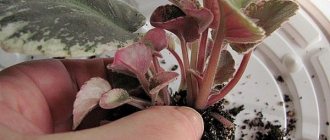Reproduction of ficus at home is a good thing and not easy. It all depends on the type of ficus and the choice of propagation method.
Regardless of the type and variety of ficus, its presence in the house is always a luxury of greenery and a piece of nature in your home. Depending on the variety, there are very colorful and variegated forms of ficus . Ficus propagation is a whole process in which you need to know and fulfill all the conditions and processes.
Ficus propagation, methods
You will need to choose a propagation method: cuttings, layering, through a leaf. You can, of course, try to propagate ficus with seeds, but this is such a long process; propagating ficus with seeds can be more difficult than other methods. As mentioned above, depending on the type of ficus and its growth form, we choose the propagation method we need. Many people use ficus propagation by cuttings, as well as other propagation methods, which we will consider below.
When is the best time to propagate ficus trees?
The best time for propagation of ficuses is spring and the first ten days of summer. It is during this period that all life processes of the plant are activated: new shoots with young leaves appear, which means the process of root formation will take place as quickly as possible.
The optimal temperature for rooting ficus is about 23-25 degrees. Lower rates significantly slow down the process of root formation and reduce the likelihood of survival of a young seedling.
Before you start breeding, you should pay attention to the temperature in the room. Additional heating of the room may be required.
Dividing the main bush
This method is very simple, usually when you replant a ficus, and it is better to do this in the spring, when the plant wakes up and enters the phase of active growth and development. When you repot a ficus, you remove the plant from its pot. Before transplanting it into a new pot, you should inspect the plant for damage and the presence of new young shoots. They usually come from the root and are located next to the main plant. This method is well suited for propagating dwarf ficus (pumil) and sometimes for rubber ficus. Especially when the plants are still young and have not formed into one trunk.
Read on to learn how to propagate ficus macrophylla and other ficus trees when dividing the main bush.
Carefully separate the young plant and plant it in a separate container or pot. We plant the main plant in a new pot. We take care of the main plant after transplantation and the new one. Both need good care, as the ficus suffered stress. Therefore, new shoots or growth of existing ones can be observed after a few weeks.
How to make a house plant beautiful?
If the ficus has grown too much, what should you do? This question often worries novice flower growers. In this case, experts advise pruning the plant. This procedure is best done in spring or summer, when the tree is actively developing. If the crown is formed in the fall during the dormant period, then the shoots will begin to grow only where pruning has been done, and you will not get an even bush. In addition, new branches will use up nutrients from the plant and weaken it during the dormant period.
It is not recommended to form a crown immediately after transplantation, so as not to increase stress. For cutting, use garden shears, pruning shears or a knife. Tools are first disinfected with an alcohol-containing solution, and the cut points are lubricated with garden varnish.
Ficus propagation by air layering
The ampelous or climbing type of ficus (pumila) can be propagated well by layering. As for other types of ficus, this method of propagation can also be used. To do this, you need to select the desired shoot and dig it in the same pot. If the shoot is long and bends well, it can be buried and secured in a separate pot, which will be located at a close distance from the main ficus pot. The shoot should be fixed in the ground. As soon as, after a while, this shoot forms roots, it can be cut off from the mother plant.
You can also use another method: for this you need to select the desired stem from the plant. and we will propagate it by air layering. We make an incision on the shoot. The juice that comes out after the cut must be removed with a napkin. We also determine the height of the cut. Typically, this method is used to rejuvenate ficus, which for some reason has lost its decorative appearance.
In the chosen place we remove the leaves; the cut should not be deep and not too long. Try to carefully insert a sliver of wood or a piece of toothpick into the cut. This will prevent the plant from tightening the cut. We treat the cut site with a root formation stimulator. Next, wrap the area with damp moss (you can use sphagnum). The area should be wrapped in film or a bag and secured. So that he doesn't fall down and move out.
We use tape or rope, but try not to overtighten. This can disrupt the sap flow in the main shoot on which we carry out the propagation method. Allowing the moss to dry out is not allowed, so we will moisten it only in one place. This place is the upper part, so there we will sometimes have to open the film and additionally moisten the moss. After a month, roots will form on the cut. You should wait until there are enough of them.
Then we cut off the shoot and plant it in a permanent place in a separate pot. We take careful care of the new shoot. It also needs high humidity and a lot of light and heat.
Transplantation
One of the important factors for favorable further development and growth is plant replanting. There are several signs by which you can determine that it is time to replant a flower:
- At the bottom of the pot there are roots sticking out of the ventilation holes;
- the soil dries out too quickly after watering;
- a tangle of roots is visible in the upper part of the soil.
How often the transplant will be carried out directly depends on the age of the plant. If these are young trees, then the pot should be changed once a year; for older plants, it is recommended to change the pot no more than once every 2 years. The procedure is carried out in early spring. When deciding to use the cut top to multiply flowers in the house, it is first kept in water until the roots appear.
Experienced gardeners say that indoor ficus can be planted in the ground without roots. However, this procedure requires certain skills, so it is better to use an accurate method and do everything correctly. When the sprout takes root, its rooting in the soil will be much faster and the plant will develop much better.
The pot is changed using the transfer method. Place drainage on the bottom of a prepared pot with ventilation holes. Then fill the universal mixture up to about half, carefully remove the flower from the old pot along with the earthen coke. There is no need to pre-water the plant before replanting. Next, they put the rhizome in a new container and cover the plant around with earth so that the neck of the rhizome is not buried, but is in the same place, otherwise the flower may die.
Ficus propagation by apical cuttings
This is a fairly proven and most popular method of reproduction. You need to select the shoot that you will use for propagation. It should be well developed and without signs of disease.
To make a good cut, you may need special tools. This could be a sharp knife or pruning shears. The instrument must be disinfected. Otherwise, you can introduce an infection both to the main plant and to the shoot for cuttings.
The cut should be made at 45 degrees. The length of the shoot can be twenty centimeters, but not less than ten. It all depends on the presence of dormant buds on the cutting and at what distance they are located. Both the main shoot of the ficus and the side shoot are suitable for cuttings. Especially if your ficus has grown and with formative pruning, you get several shoots that can be used for propagation.
Inspect the cutting to ensure that its bark is intact and without signs of damage. If desired, you can shorten the stalk or divide it into several parts.
Next, we take a container of water, it should be at room temperature, and we place our cuttings in it. We change the water in a glass or jar regularly, this will not allow it to stagnate. To prevent the cuttings from rotting, crushed tablets (activated carbon) can be added to the water. The container for cuttings (if it is a jar) must be wrapped in something dark, or use a dark container.
This is necessary so that the water does not begin to bloom in bright light. If you get very short cuttings. Then they can be fixed at the edge of the container. You can use a circle made of paper or cardboard. Be sure to tear off the lower leaves of the cuttings, and generally try to ensure that the remaining leaves do not touch the water. Only the lower part of the shoot/cutting should be in the water.
Place the container with the cuttings in a warm and bright place. The cuttings should not be exposed to direct sun, but the area should be well lit. If moisture begins to evaporate in your container. Water can be added to the desired level. Or replace it completely.
You can use cuttings for propagation directly into the ground. To do this, we simply take a container in which we will root our cuttings. We use a mixture of peat and sand, for better rooting, the ends of the cuttings can be treated with root formation stimulants.
We simply stick the cuttings into the prepared soil. But in this case, you will need to use a greenhouse. It can be made from a plastic bag or plastic bottle. This is necessary in order to maintain constant humidity.
Ficus trees do not take root quickly, so be prepared to wait a few weeks. If you used a container with water, then you can determine whether there are roots on the cuttings by simply inspecting the cuttings. When roots appear, we take the cuttings and plant them in a permanent place, in the required pot size. But when using ficus cuttings and its rooting in the soil, here we look at the appearance of new leaves on the cuttings.
As soon as new leaves appear, the cuttings can be replanted. But my advice is this: use a separate pot for each cutting, or use peat pots. This is necessary so that when transplanting to a permanent place, you minimally injure the young roots. Than if you planted several cuttings in one pot.
Planting and growing a shoot in the ground
There is another way to initially grow a plant after cuttings of the shoot have been processed. To do this, the specimen is not lowered into water, but planted directly in the ground. Considering that not everyone knows how to do this correctly, it must be said that initially a pot for the ficus is chosen (it should be small in size), and then shards, pebbles or expanded clay are poured onto one. All this is drainage, which is necessary so that the plant does not rot. Next, moss is laid out, it is necessary so that the drainage does not become clogged with the substrate, and excess moisture does not accumulate in the soil.
The substrate must include:
- sand;
- perlite;
- vermiculite;
- peat.
The shoot is planted in the ground in such a way as to deepen the lower node. After this, the flower is thoroughly watered. If the ficus benjamina (future ficus) has a very weak layer, then it would not be a bad idea to support it. Small pegs are suitable for this.
After this, the pot is sent to a warm and humid place. In this case, it is necessary to ensure that the sun does not shine on the young flower during the day. For the process to be successful, certain conditions must be maintained. In cases where such cannot be created, a mini-greenhouse is made, which is ventilated from time to time. Particular attention is paid to the substrate - it should be moderately moist, but not wet.
The first leaf will appear no earlier than in 3-4 weeks. From this moment on, certain changes occur in the cutting due to its growth. At this stage, you can be sure that rooting has occurred and was successful.
Ficus propagation by stem cuttings
When propagating ficus using this method, ficus plants with large leaves are mainly propagated. This is a good way to use part of the stem that has either a leaf or several buds that will later become shoots. If you take a large stem, it can be divided into several parts and used for propagation.
This method is good if you decide to trim or rejuvenate your ficus, or if it happens that the shoot is broken. We take the stem we need, which we will propagate. It can be divided into several parts. The length of each should not exceed five centimeters. And on each piece of shoot there should be a dormant bud or leaf.
This method of propagation involves immediate planting in prepared containers and soil. Use regular soil or prepare a mixture of peat and sand. Be sure to add perlite/vermiculite. For good rooting, the soil can be disinfected. Or we use special drugs. or it can be calcined in the oven (especially for garden soil or soil from the street). If your cutting has a leaf, it needs to be rolled into a tube. This will prevent the leaf from evaporating much moisture and taking nutrients from the shoot. If there is no leaf, then we leave the cutting as is. In both cases, you should provide good humidity. Therefore, we make a greenhouse from a bag or a plastic bottle.
For this cutting method, you need to choose an already mature shoot that is well developed and completely woody.
Growing a plant in an apartment or house
Ficus is a very unpretentious plant; even a novice gardener can easily grow it. How to care for ficus? To do this, the following conditions must be created:
- Lighting is a light-loving plant, especially for ficus plants with variegated foliage. With a lack of light, the foliage loses its attractiveness. But direct sunlight is contraindicated.
- The most favorable temperature is from 18 to 24 degrees. When it drops to 12 °C, leaves begin to fall off. Plants with dark foliage are less sensitive to cold and can withstand short-term drops of up to +5 degrees. In winter, ficuses feel good at 15–17 degrees.
- Air humidity - ficus prefer humid air, so it is necessary to spray them in a dry room and wash them in the shower.
- Watering is regular twice a week in summer and twice a month in winter.
- The soil must contain nutrients and be loose. It is prepared from equal parts of humus, river sand, turf soil and peat.
- Fertilizers - once every ten days during the period of intensive growth, alternately feed with organic and mineral compounds.
- Crown formation - pruning is carried out at the end of winter to make the plant look lush and well-groomed.
- How to plant ficus is described in the article, young plants are replanted annually, adults - much less often or simply change the top layer of soil.
If you follow some simple rules, ficus trees will always delight you with fresh, neat greenery.
Ficus propagation by seeds
This method is used when there are ripened ficus seeds. It doesn't matter how they got to you. Did you buy them at an exhibition or in a specialty store? Or they were presented to you by friends. Ficus plants that have gone through the process of flowering and seed ripening can be propagated by seeds. Unfortunately, ficus trees do not bloom at home, but in their homeland they bloom under natural conditions.
Seeds should be prepared before planting. To do this, soak them in water for a day, adding a growth stimulator to it. We take ready-made soil, which can also be purchased at the store, and add sand to it. Before planting, seeds should be washed with running water. It is better to choose a container for growing seeds that is not deep and rectangular in shape. This is necessary for the seeds to germinate and sprout. Next we will transplant them into other pots. The container for germinating seeds must have good drainage. This will prevent stagnation of moisture and make it possible to avoid rotting of the seeds.
We fill the container with soil and if the seeds are large enough, you can make holes for planting, but not deep ones. If the seeds are small, then sow them superficially. Sprinkle the top with soil or coarse sand. There is no need to water - just spray the container well with a spray bottle. Next, you need to take care of constant humidity and temperature. Keep the container in a warm and bright place. As soon as the seeds germinate, we wait for two or three leaves and can be transplanted to a permanent place in separate pots.
Ficus propagation by leaf
To do this, we use a good and healthy leaf. The tip where the cut was made needs to be treated with a stimulant and you can put it in water (more like the method of propagation by cuttings) or you can immediately plant it in a prepared container with soil. When planting directly into the ground, the leaf must be rolled up and slightly dried.
Afterwards we plant it in the ground and cover it with a bag or plastic bottle. Keep in a bright and warm place. From time to time you can remove the bottle for a while. This will make it possible to ventilate the leaf and prevent it from rotting. But it’s better to use a bottle, cut off the bottom, while leaving the top with a lid. We cover our ficus, and to ventilate and saturate our ficus leaf with oxygen, just open the cap of the bottle.
To summarize, we can say that almost all ficus plants can be propagated at home. Some things are more complicated, some things are simpler. When using the cutting method, you can propagate almost any type of ficus.
When using the method of propagation by layering or rooting a shoot, this is best for ampelous ficus, such as dwarf ficus (Pumila) or for other ficus, if it allows you to root the shoot and tilt it towards the ground. It is better to propagate the rubber plant by leaf; it has a leathery leaf and is better suited for propagation by leaf. Good luck to you.
How to grow a shoot in water
Correctly taking a shoot from a ficus is only half the battle. An equally important aspect is to grow this cutting correctly so that it takes root. Many gardeners recommend growing in water. Everyone can do this.
And the manipulation is performed in this way:
- Pour clean water into a transparent container, and then lower the sprout with leaves into it. It is very important that the sheet plates are above the water without touching the liquid.
- Add some charcoal to the water.
- Throughout the process, water will need to be added as it evaporates. Do not change, but add a new one.
For 30 days, the container with the cuttings should be kept in a bright and warm room. Particular attention is paid to humidity; it should not fall below 80%. Considering that not everyone can do this, you should make a small greenhouse. Once the roots appear, the cuttings can be transplanted into a previously prepared substrate.
Important! If roots have not appeared within two months, then most likely the planting material is not suitable or something was done incorrectly.
In this case, it is recommended to repeat the procedure, but with a new copy.











